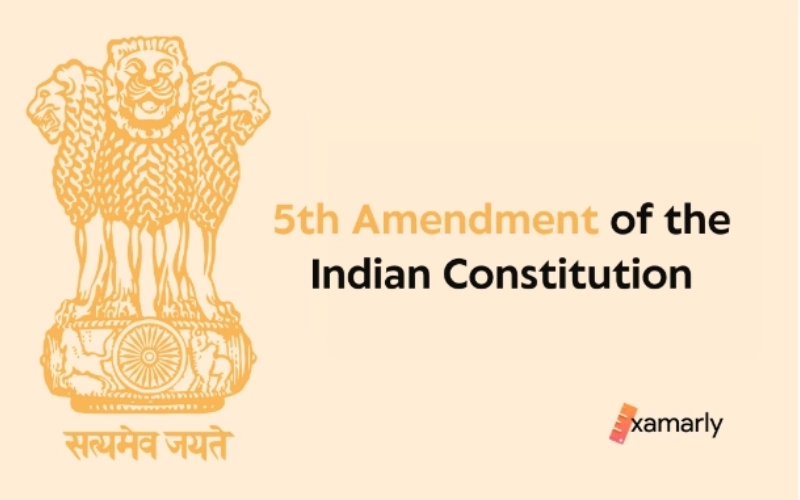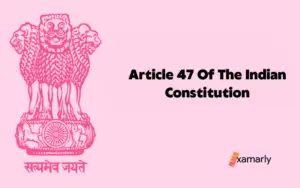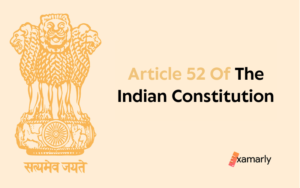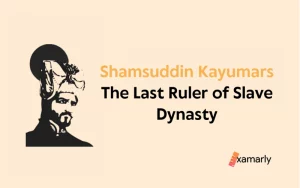The 5th Amendment of the Indian Constitution (also called The Constitution Act, 1955) made certain changes. It empowered the President to prescribe a limit to how long state legislatures can express their views. The changes made were made to Article 3 of the constitution. It is the first amendment in the world to grant people the right to vote for their government.
If you would like to learn more about this amendment, read on! 5th amendment of the Indian Constitution is covered under the Indian Polity of the UPSC syllabus. This article will help you in your UPSC CSE preparation.
Understanding the 5th Amendment of the Indian Constitution
The 5th Amendment of the Indian constitution re-enacted the proviso to Article 3.
The President was given the power to set a deadline for State legislatures to submit comments on proposed Central laws relating to the creation of new States and changes to the areas, boundaries, or names of existing States by the Constitution (Fifth Amendment) Act of 1955, the formal name of the 5th Amendment of the Indian Constitution.
The amendment also prohibited the introduction of any such bill into the Parliament of India. It was so until after the specified or extended term had elapsed and authorized the President to extend the restriction. The conclusion of the fifth constitutional amendment led to a major change. Hence, the proviso to Article 3 of the constitution was introduced.
History behind the 5th Amendment of the Indian Constitution
Three key factors led to the original Article 3 being written as it was:
- When it was written, the Princely States were still not entirely united.
- There was also a chance that states would be reorganized based on their respective languages, and
- the Constituent Assembly anticipated that this option would not be delayed for very long.
As a result, Article 3 was added to the Constitution, allowing a quick and straightforward way for the states to have the possibility of reorganization at any moment.
Problem with Article 3
When it was discovered that the initial version of Article 3 did not include a deadline for the states in question to voice their opinions, a problem developed. The absence of such a constraint could slow or even halt parliamentary legislation intended for the stated goal.
The Parliament, however, prevented the government of India from moving on with the rearrangement of the states on a linguistic basis by simply failing to express its opinions for an extended period of time.
Resolution of Problem with Article 3
The 5th Amendment of the Indian Constitution improved the efficiency of state reorganization procedures, which encouraged the states to investigate their own problems properly.
Following the amendment, the process was altered, and the following requirements apply to the Parliament’s use of this authority:
- The 5th Amendment of the Indian Constitution made it feasible for the President to specify a deadline or prescribed limit through which the Parliament might move forward with the topic without first seeking the opinions of the state in question.
- Before suggesting to Parliament that a Bill be considered if it changes a State’s territory, name, or boundaries, the President must first refer the Bill to the relevant State Legislature, which has a set period of time in which to respond.
Proposal and Enactment
No bill for the formation of a new state, expanding or reducing the area of any state, or revising the boundaries or name of any state may be brought in Parliament without the President first ascertaining the opinions of the State Legislatures concerned with respect to the terms of the law.
This is in accordance with the proviso to Article 3 of the Constitution (relating to the formation of new States and alteration of areas, boundaries, or names of existing States).
The President should be able to specify the time limit for the states to submit their opinions when a reference to the State Legislatures for the aforementioned purpose is made, and he should be free to extend that time limit as often as he sees fit.
Additionally, it was thought beneficial to stipulate that the bill wouldn’t be introduced until after the end of the waiting time. The proviso to Article 3 was intended to be changed in accordance with the 5th Amendment of the Indian Constitution.
Three significant factors led to the original Article 3 being written as it was;
- (a) the Princely States had not yet achieved full integration at the time it was written;
- (b) the possibility of reorganizing states based on linguistics; and
- c) the Constituent Assembly had anticipated that such reorganization could not be delayed for very long.
As a result, Article 3 was added to the Constitution, allowing a quick and straightforward way for the states to be reorganized at any moment.
On November 21, 1955, the Lok Sabha was the first to hear about the Constitution (Fifth Amendment) Bill, 1955. Minister of Law and Minority Affairs at the time, C.C. Biswas, proposed it.
It intended to alter Articles 3, 100, 101, 103, 148, 189, 190, 192, 276, 297, 311, 316, and 319 of the Constituent power.
The measure, however, was unable to be brought up for the House’s consideration and expired with the dissolution of the First Lok Sabha. The administration believed that the Constitution (Fifth Addition) Measure would take a very long time to be resolved because it aimed to alter multiple articles, so it decided to present a new bill to hasten consideration and passage of the amendment to article 3.
To accomplish this, C.C. Biswas introduced the Constitution (Seventh Amendment) Bill, 1955, which attempted to modify article 3, in the Lok Sabha on November 28, 1955. The Constitution (Fifth Amendment) Bill, 1955 had a clause that was a copy of precisely clause 2 of this bill, which aimed to change article 3.
On November 30, 1955, a proposal was made to refer the Seventh Amendment Bill to the Select Committee. As required by the House’s rules of procedure, a special majority was needed for this motion to pass.
The government then proposed the Constitution (Eighth Amendment) Bill, which aimed to change Article 3 of the Constitution. On December 9, 1955, H.V. Pataskar filed a new bill that attempted to alter Article 3 of the Constitution. H.V. Pataskar was the Minister of Legal Affairs then.
On December 12 and 13, the Lok Sabha considered it. Further on December 13, 1955, it was approved in its original form. After the Bill had been approved by the House, the amendment took place.
The Speaker did a formal amendment replacing the brackets and the words “(Eighth Amendment)” in clause I. It was changed to the brackets and the words “(Fifth Amendment)”. The Rajya Sabha debated. Further, the Bill was allowed on December 15, 1955, as amended.
On December 24, 1955, then-President Rajendra Prasad gave his approval to the bill, which was then published in The Gazette of India on December 26, 1955. The Fifth Amendment becomes operative on December 12, 1956.
Constitutional Changes
The 5th Amendment of the Indian Constitution made significant changes to Article 3 of the Constitution. This article now specifies that as long as the proposal contained in the bill does not change the territory, limits, or name of any of the States listed in Part A or Part B of the First Schedule, no bill for the objective may be filed in either House of Parliament without the President’s advice.
The President referred the Bill to the legislature of that State for their input, which they were to provide within the time frame mentioned in the reference or any additional time the President may grant, however, that time frame has already passed.
Confusion regarding the Meaning of the Phrases
Following the modification, there was a lot of misunderstanding about what was meant by “express view of the State Legislature,” which led to a flagrant breach of Article 3 and a drastic increase in the number of cases.
When the State Reorganization Bill was introduced in the Lok Sabha, the Supreme Court issued its decision in Babulal Parate v. The State of Bombay to finally put the confusion to rest.
A proposal for the creation of three separate units was included in several of its sections. More specifically it was done in Clauses 8, 9, and 10, namely the Union Territory of Bombay, the State of Maharashtra containing Marathwada and Vidharbha, and the State of Gujarat including Saurashtra and Cutch.
Clauses 8, 9, and 10 in particular proposed the creation of three distinct units:
- the Union Territory of Bombay;
- the State of Maharashtra, which included Marathwada and Vidharbha; and
- the State of Gujarat, which included Saurashtra and Cutch.
Conclusion
To sum up, we can say that the 5th amendment of the Indian Constitution was helpful and that it helped reorganize the states in accordance with what was needed. As a result, the amendment that added the time limit sections encouraged both the state administrations and the Parliament to take an interest in issues connected to state reorganization.
FAQs related to the 5th Amendment of the Indian Constitution
What was Article 3 before the 5th Amendment of the Indian Constitution?
Before the 5th Amendment of the Indian Constitution, Article 3 stated:
By legislation, Parliament may
(a) create a new State by dividing territory from an existing State, joining two or more States or portions of States, or joining any territory to a portion of an existing State; (b) raise or decreasing the area of any State; (c) change any State’s boundaries, or (d) change any State’s name.
No Bill for this purpose may be submitted in either House of Parliament except on the suggestion of the President and unless, where the proposal in the Bill affects the boundaries of any State or States named in Part A or Part B of the First Schedule or the name or names of any such State or States, the opinions of the Legislature of the State or, as the case may be, of each of the States both with respect to the intention to present the Bill.
Which articles of the Indian Constitution did the 5th Amendment Bill intend to modify?
The Constitution (Fifth Amendment) Bill, 1955 intended to alter Articles 3, 100, 101, 103, 148, 189, 190, 192, 276, 297, 311, 316, and 319 of the Indian Constitution.
When did the 5th Amendment of the Indian Constitution come into effect?
The 5th Amendment of the Indian Constitution was assented to on 24th December 1955 and commenced on 12th December 1956.






